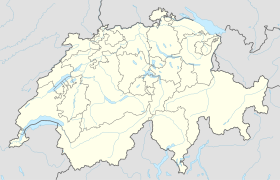Trim stone
| Trim stone | ||
|---|---|---|
| State : |
|
|
| Canton : |
|
|
| Administrative district : | Bern-Mittelland | |
| Residential municipality : | Münsingen | |
| Postal code : | 3083 | |
| former BFS no. : | 0631 | |
| Coordinates : | 610 856 / 194 856 | |
| Height : | 630 m above sea level M. | |
| Area : | 3.6 km² | |
| Residents: | 509 (December 31, 2012) | |
| Population density : | 141 inhabitants per km² | |
| Website: | www.muensingen.ch | |
| map | ||
|
|
||
Trimstein was a municipality in the Bern-Mittelland administrative district of the canton of Bern in Switzerland until December 31, 2012 . Trimstein only became an independent municipality on January 1, 1993 when it separated from Rubigen . On June 18, 2012, the merger with Münsingen on January 1, 2013 was resolved with a yes-vote share of 84.5% .
geography
Trimstein lies at 630 m above sea level. M. , four kilometers north-northeast of Münsingen and eleven kilometers east-southeast of the canton capital of Bern (as the crow flies). The village extends over a leveled area on the western slope of the Ballenbüel ( Hürnberg ), in a position with great views on the eastern flank of the Aare valley about 100 m below.
The area of the 3.6 km² former municipal area covers a section of the hill country east of the Aare valley between Bern and Thun. The area is characterized by various hills and moraine walls , which the Aar glacier deposited during the last ice age . The former municipality extends from the formerly swampy area with the Trimsteinmoos and the Eichimoos ( 585 m above sea level ) eastward over the gently sloping slope from Trimstein to the heights near Herolfingen. Below the Huttibühl is 720 m above sea level. M. reached the highest point of Trimstein. The northern former part of the municipality is drained to the Worblen. In 1997, 7% of the former municipal area was accounted for by settlements, 12% for forests and woodlands and 81% for agriculture.
Trimstein includes the hamlet of Eichi ( 601 m above sea level ) on the slope above the Eichimoos, as well as some farm groups and individual farms. Trimstein's neighboring communities were Worb , Schlosswil , Konolfingen , Münsingen and Rubigen .
population
With 509 inhabitants (as of December 31, 2012) Trimstein was one of the small communities in the canton of Bern. 99.2% of the residents speak German and 0.8% speak French (as of 2000). The population of Trimstein was 431 in 1992 and 482 in 2000.
economy
Trimstein was predominantly an agricultural village until the second half of the 20th century . Even today, the agriculture , the dairy industry and the livestock a role in the employment structure of the population, but it is not as high as before. Further jobs are available in local small businesses and in the service sector. In the last few decades the village has developed into a residential community thanks to its attractive location. Many employees are therefore commuters who work mainly in the larger towns in the area and in the agglomeration of Bern or Thun.
traffic
The former municipality is located off the major thoroughfare on a connecting road from Münsingen to Worb. The closest connection to the A6 motorway (Bern-Thun) is around 5 km from the town center. Trimstein has no direct connection to the public transport network. The Bern-Lucerne railway line runs through the village, but has no stop here. The next train station (Worb SBB) is around 1.5 km outside Trimstein. Other train stations are in Münsingen, Rubigen and Tägertschi .
history
The first written mention of the place took place in 1148 under the name Trimesteim ; from 1268 the name Trimstein has been handed down. The place name goes back to the Old High German word tirmin (border), a loan word from Latin ( terminus ). In a sales deed from 1341 Peter von Trimstein, his son Heinrich and his nephew Werner are mentioned. The Trimstein rule had actually belonged to the Worb rule since 1498 . The Konolfingen Regional Court exercised high jurisdiction over the area. After the collapse of the city and republic of Bern (1798), Trimstein belonged to the Höchstetten district during the Helvetic period and from 1803 to the Konolfingen Oberamt, which received the status of an official district with the new cantonal constitution of 1831. Since the 19th century Trimstein has been one of the three district communities of the Rubigen community. On September 24, 1989, the split of this community was decided by a large majority. With effect from January 1, 1993 Trimstein was therefore raised to an independent municipality.
Trimstein was an independent municipality until December 31, 2012 .
Attractions
In the old town center, numerous characteristic farmhouses in the Bernese country style from the 17th to 19th centuries have been preserved. Trimstein does not have a church, because it has belonged to the Münsingen parish since the Middle Ages.
Web links
Individual evidence
- ↑ http: //www.münsingen.ch/politik/abstimmen-wahlen/lösungen-gemeinde/ ( page can no longer be accessed , search in web archives ) Info: The link was automatically marked as defective. Please check the link according to the instructions and then remove this notice. (accessed on: June 18, 2012).
- ↑ Archived copy ( memento of the original from June 25, 2012 in the Internet Archive ) Info: The archive link was inserted automatically and has not yet been checked. Please check the original and archive link according to the instructions and then remove this notice. (accessed on: June 21, 2012).
- ^ State archive of the canton of Bern , document, subject Herrschaftsarchiv Worb, 1341.02.01.


